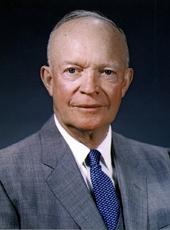
Remarks at Annual Dinner of the Association of State Planning and Development Agencies.
Mr. President, Mr. Chief Justice, Ladies and Gentlemen:
I'm delighted to have this moment to greet the members of the planning profession.
Planning has become an indispensable feature of living in this complex age.
Occasionally, people come to my office, or I meet them, and the word "planning" comes up. I am struck by the fact that so often the individual to whom I am talking seems to think there is something a little phony about the word planning. On the one end it's probably considered apparently academic or theoretical, with no practical application, and the other end of the spectrum it's rather an attempt to express an idea of being "bossy" in telling other people how they should live. And I normally try to get the matter in perspective by illustrating from military experience what planning is.
Now in World War II, I suppose there were--in the Pacific and in the Atlantic--let us say, 20 amphibious landings. And I say to these people, "How do you suppose these things happen?" Let's assume that we didn't have to plan to get the ships to sea or the people on them, we just thought we're out there. We had them. And now, suddenly, someone said "Well, let's land." Can you imagine the confusion and the defeat that would have been inflicted upon any such force? Actually, the days and weeks, and even months, and indeed in the case of Overlord, 2 years and 2 months of definite planning before it was accomplished, is usually my answer as to what planning means to success in positive operations.
Now, if you were in a wilderness, a home built without regard for planning might damage no one but the owner. But in crowded cities and under conditions where the boundaries of cities are colliding with each other, we must plan skillfully or the result is chaos.
Our past failures to look ahead resulted in wasteful use of land; overlapping, duplicating, and inefficient services; and critical congestion.
Growth in America has far outdistanced the forecasts of a generation ago. Right now--just a few blocks away--in the lobby of the Commerce building, a population clock registers an added American every 11 seconds--a net increase of approximately one million every 4 months. This means that just to keep our present level of living, we continuously need more houses, more schools, more hospitals, more streets and water supply systems, more waste treatment and air pollution works, more parks and recreational facilities.
Our population is only one reason that we must attract more first-rate people into the planning profession. We are a nation on the move; from country to city, from central city to suburbs, from metropolitan areas to urbanized regions in the corridors between metropolitan areas.
In the decade just past, 12 million people have moved into the suburbs--the largest population movement in the shortest time of our history. Today, the suburbs grow 7 times as fast as the cities. Someone has facetiously described one metropolitan area, of the West, as suburbs in search of a city."
Clear it seems that in the not too distant future, the entire eastern seaboard, from Portland to Norfolk, will become one continuous urban area. A new term--megalopolis--has already slipped into our vocabulary to describe these giant groupings of central cities and suburbs.
We must see to it that this growth is not like that of Topsy. It must have method, commonsense, direction, and it must be orderly. This calls for new approaches to problems of expansion that have all but erased outmoded boundaries.
Urbanization does not recognize boundary lines, whether municipal, town, county, or State. Neither does a public facility, such as a water supply net, a transit system, or a program to reduce contamination of the air. And public services must follow the needs of the people and this means that more and more these services must cross, indeed ignore, traditional borders.
The Federal Government stands ever ready to help stimulate, and is making its facilities available to help, planning at the State and local level. But we are equally determined not to supersede local responsibility.
It is the States themselves, or States cooperating among themselves, with the power inherent in their sovereignties, which must provide authority for local, regional, and metropolitan area planning units.
But I must also add, as we plan for tomorrow, our efforts must embrace more than the initiative of government, no matter what its level.
To make our dollar go as far as possible our choice should be based on needs, objectively determined, and not on just the desirable.
I believe, as I stated recently, that such are the dimensions and problems of life in this great Nation, that we should set for ourselves a series of goals--goals that take into account our growth potential and define the methods needed for their attainment.
You as members of the planning profession are acutely aware of the need for imagination in setting some of these goals, including those applicable to rapid urbanization. To my mind this is the very core of intelligent planning.
So, to each of you, in your dedicated task of building a better America, I wish for you: opportunity, its fulfillment, and Godspeed. And thank you very much.
Note: The President spoke at the Statler Hilton Hotel, Washington, D.C. His opening words "Mr. President" referred to William D. Carlbach, President of the Association.
Dwight D. Eisenhower, Remarks at Annual Dinner of the Association of State Planning and Development Agencies. Online by Gerhard Peters and John T. Woolley, The American Presidency Project https://www.presidency.ucsb.edu/node/235450

